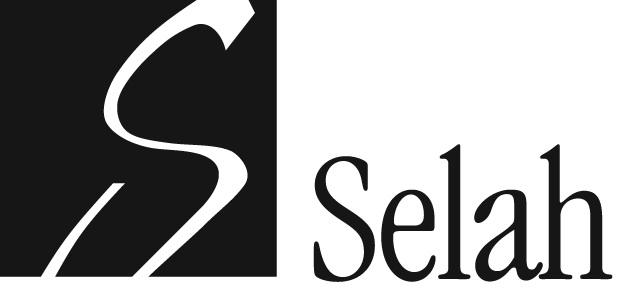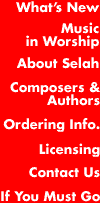| |
|
Music
in Worship is Selah's occasional
newsletter for church musicians, with interviews and helpful
articles for choir directors, organists, and leaders of congregational
song
Worship
Using Instruments in Worship
Jayson Rod Engquist
Music for worship often begins and ends with
solo organ or piano preludes and postludes. For many years I
have wondered whether the time spent preparing this music is
well invested, when the majority of worshippers are either whispering
to each other before worship or speaking loudly to each other
afterwards. After many discussions with other church and temple
musicians, I have decided we are all partly at fault for conditioning
our congregations. By using the same instrument week after week,
playing at approximately the same level, the music quickly becomes
"Muzak." The music drifts to the subconscious, just
like at the dentist's office. What can we do to break this habit?
Most congregations have amateur musicians
as members who either play an instrument or who have had training
in music. Some have grown up with the obligatory two to five
years of private piano study. Others were fortunate enough to
have school systems that trained children, at an early age, to
read musical notation and sing and/or play the music as well.
These musicians can be tapped to provide a supplement to the
"regular" musical offerings before, during, and after
worship services. Of course, if you are lucky enough to have
both a budget and available "professional" instrumentalists,
the sky is the limit.
There are many resources available for finding
music for keyboard (organ, piano, or electronic) and other instruments.
I recently completed editing the fourth edition of Organ Plus
for the American Guild of Organists. This catalogue of music
for organ with other instruments lists almost 1,500 different
works for all kinds of combinations: from flute and organ to
harp, organ, clarinet, and timpani. It is available directly
from the A.G.O. in New York City. The New York State School Music
Association puts out a resource manual (aimed at contests and
festivals) which is "graded" by level of ability. (Your
local association might have a similar publication.) Many combinations
are listed, and even a student who has had only two or three
years of study can find appropriate music for worship. A student
trombone player, for instance, could be utilized in playing prelude
and postlude music in addition to playing along on the hymns.
The experience gained by the student is invaluable, and the congregation
also benefits. Suddenly the worshippers hear a "new"
sound in their sanctuary and sit up, stop chatting, and take
notice.
Many congregations and schools now own handbells
or tone "chimes" that are sold in sets. Institutions
usually order three octaves of bells or chimes, and these can
be effectively and easily rung by 10 or 11 ringers. There are
numerous works now published for organ, choir (and/or congregation),
and handbells. These are often arranged for alternate stanza
singing by both choirs and congregations. Additionally, many
of these arrangements include parts for other instruments including
bells. Some publications have "specific" bell parts
that are arranged and notated. Others employ "random"
ringing (actual bell notes are suggested and rung at will) during
hymns, anthems, and/or organ works.
Almost everyone can learn to ring bells, even
if they cannot read music. Correct ringing technique is easily
and quickly taught and most people have fun ringing, because
they are able to immediately make a pleasing musical sound on
this "instrument" (and in combination with other bell
ringers on their "team") without years of music study
or lessons. For more advanced bell literature, knowledge of musical
notation is very helpful. Almost all publishers now have a separate
category for anthems that have handbell parts. It is also very
easy to "arrange" almost any hymn to employ handbells
by having the ringers learning and playing three chords (tonic,
sub-dominant and dominant) along with the organ. They can be
quickly marked (I, IV, or V) in the hymnal for each bar and the
bell-ringers can play along. This can add a pleasing sound to
the "usual" (organ only) accompaniment and put smiles
on people's faces.
Never did I think I would see the day when
an electronic substitute would sound like a real piano. With
new technology, sounds can be digitally "sampled" and
authentically reproduced. Most keyboards are now equipped with
touch sensitive keys that are weighted just like a real piano
action. Korg, Yamaha, Roland, Kurzweil, and other quality brands
are available in music stores around the country. These keyboards
are also equipped with MIDI (Musical Instrument Digital Interface)
connectors that can be hooked together and to computers. The
MIDI "language" is now a universally standardized language
that is "understood" by most brands of equipment. I
only mention these keyboards because they open up a new realm
of sounds to experiment with in worship. As long as a live person
is playing the instrument in "real" time, I have no
objection to their use in worship. Electronic instruments are
here to stay, and many people (especially younger musicians)
are intrigued by the possibilities they present.
I encourage you to dig deep to find the amateur
instrumentalists in your congregation. You may be surprised to
find a classical guitarist, a saxophonist (which is a wonderful
combination with organ), or untrained people who are willing
and even excited about participating in the musical life of your
institution that couldn't do so previously. Consider an organ
"plus" worship experience.
-Jayson Engquist
|


